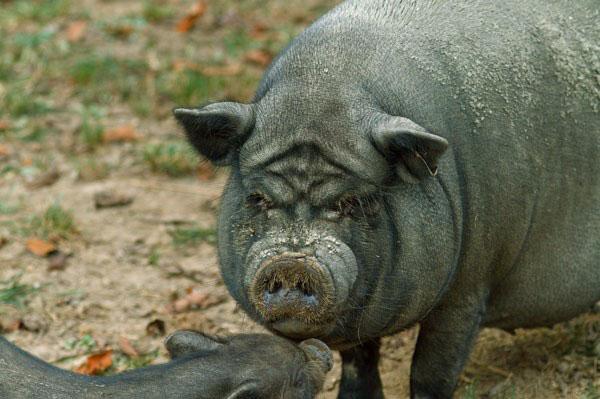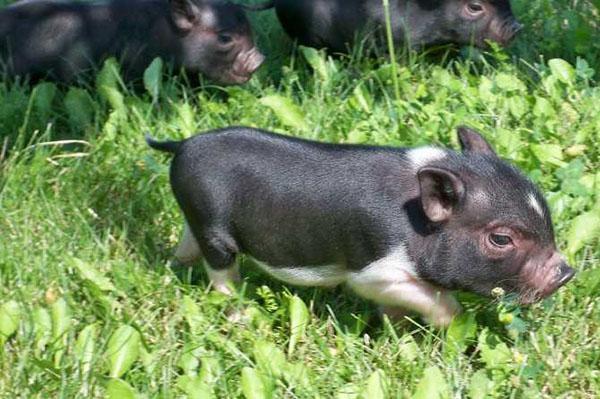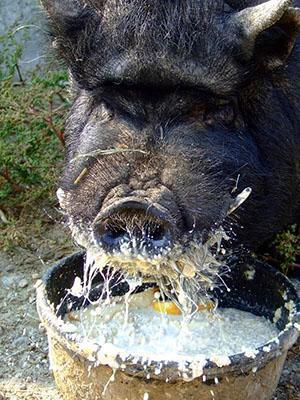Keeping and breeding Vietnamese piglets
 Among American and European livestock breeders, Vietnamese piglets became famous only at the end of the last century. In Russia, this variety of domestic pigs appeared even later, but the interest in unusual animals turned out to be huge.
Among American and European livestock breeders, Vietnamese piglets became famous only at the end of the last century. In Russia, this variety of domestic pigs appeared even later, but the interest in unusual animals turned out to be huge.
How do Vietnamese pot-bellied pigs differ from traditional ones, and what are the advantages of animals of this breed? Compared to old breeds of domestic pigs, the capabilities and potential of these animals are not fully understood, and breeders are working to improve the available material. But it is already clear that the four-legged immigrants from Vietnam have a great future.
Characteristics of Vietnamese pot-bellied piglets
Asian or, as is often said, Vietnamese pigs stand out:
- early maturity;
- stable weight gain;
- unpretentiousness when choosing food;
- undemanding content;
- cleanliness.

At home, Vietnamese piglets live in a humid subtropical and tropical climate, but this does not prevent the animals from successfully adapting to the more severe climate of the Russian central zone.
Pigs have excellent immunity, they can easily resist common diseases of domestic animals, and with good care, Vietnamese piglets are even more profitable in breeding than many already proven breeds. This is facilitated by the fact that the animals are distinguished by a strong physique, which speaks of a meat orientation, and their meat is juicy, the amount of bacon is small.
What do Vietnamese pigs look like?
Vietnamese pot bellies have a very memorable appearance. Among the characteristic features of the breed:
- predominantly black color of animals;
- wide chest, powerful back and strong short legs, making the pigs stocky;
- shortened structure of the muzzle;
- medium-sized erect ears.
The breed owes its name to another feature - the voluminous drooping bellies that appear in growing Vietnamese piglets.
 Such "decoration" in an adult boar can practically reach the level of the soil, which, however, does not prevent the animals from maintaining mobility and enviable activity.
Such "decoration" in an adult boar can practically reach the level of the soil, which, however, does not prevent the animals from maintaining mobility and enviable activity.
The funny appearance of young Vietnamese piglets, as in the photo, sometimes attracts the attention of lovers of decorative animals. But in this case, it must be remembered that, despite the cleanliness, the piglets remain representatives of their own species, and the miniature pigs quickly turn into powerful animals. By the time of puberty, animals reach a weight of 30–35 kg, and an adult breeding boar or sow weighs up to 150 kg.
Keeping Vietnamese piglets
For ease of care when breeding Vietnamese piglets, animals are assigned a dry, warm, ventilated room. The floor in the pigsty must be level, solid, and suitable for repeated cleaning and disinfection. It is best if it is concreted. A boardwalk is made on top of such a covering.
 Compared to other breeds, Asian pigs are rather small, so they do not require a lot of space for placement. The machines are made taking into account the possibility of their daily cleaning.
Compared to other breeds, Asian pigs are rather small, so they do not require a lot of space for placement. The machines are made taking into account the possibility of their daily cleaning.
How many Vietnamese pigs to keep on the farm is up to the livestock breeder himself, but a pen with an area of 4 to 5 square meters should account for:
- a pair of adult females;
- one male;
- one sow with a litter.
For the winter period, heating is provided in places where Asian pigs are kept, it is especially important to keep warm when small piglets appear, whose immunity and protection from negative environmental factors depend only on receiving mother's milk and human care.
In the warm season, the animals are provided with walking. The yard must be protected from the wind. In case of rain, they definitely arrange reliable sheds, at the height of the pigs' growth, they fill boards on which you can scratch their backs, take out feeders and containers with water.
Organization of catering for the breeding of Vietnamese pigs
 The novelty of the breed gives rise to a lot of not very correct information concerning, among other things, animal nutrition. Sometimes it is advised to build the diet of Vietnamese piglets exclusively on green feed. Indeed, the volume of the stomach and the peculiarities of the digestive system of pigs allow assimilating a large amount of grass, but in this case there is no need to expect good weight gain and quality of meat. Greens will force animals to eat huge amounts of feed to produce a lot of waste, but the effectiveness of such a diet is low.
The novelty of the breed gives rise to a lot of not very correct information concerning, among other things, animal nutrition. Sometimes it is advised to build the diet of Vietnamese piglets exclusively on green feed. Indeed, the volume of the stomach and the peculiarities of the digestive system of pigs allow assimilating a large amount of grass, but in this case there is no need to expect good weight gain and quality of meat. Greens will force animals to eat huge amounts of feed to produce a lot of waste, but the effectiveness of such a diet is low.
How to feed Vietnamese piglets at home? In household farms, the diet of piglets bred for meat is based on high-calorie grain mixtures with the inclusion of green plants, which is especially justified in the summer. Instead of the roughage that pigs usually receive, such as straw or root vegetables, hay is offered to Vietnamese pigs with bellies.
A cereal-based feed mix is made with an emphasis on barley and wheat. They digest well and provide bacon-type body mass gains. These cereals should account for up to 70% of the feed volume.
 Indigestible grains such as oats, peas and corn are included in the feed at 10% of the total:
Indigestible grains such as oats, peas and corn are included in the feed at 10% of the total:
- All types of grain are pre-crushed and poured with boiling water to obtain a nutritious wet mixture.
- For 8-9 liters of water, there should be half the volume of cereals and a small spoonful of salt.
- After 10-12 hours of steaming, the food is ready.
- For greater efficiency of the diet, vitamins, digestive stimulants, and fish oil are added to food.
For sows waiting for the offspring and already caring for the piglets, the menu is made more varied by adding fermented milk products, reverse, chopped boiled eggs to the mixture.
Good results are obtained by feeding Vietnamese pot-bellied pigs with thick cereal porridge. In winter, pre-harvested pumpkins and carrots are introduced into the diet. Animals love vitamin hay based on legumes such as alfalfa, vetch, clover. Up to 15% of the feed, especially in the cold season, can be boiled potatoes
Vietnamese pig breeding
Self-breeding of Vietnamese pigs requires compliance with some rules. For mating, females older than 4 months of age, who have gained weight more than 30 kg, and males from six months are selected. In this case, animals should not be in closely related relationships.
You can add a boar to a pig when it shows signs of hunting:
- not passing anxiety;
- swelling or discharge in the genital loop.
Home-bred Vietnamese pigs are allowed from the burden 114-118 days after mating. The pig warns about the approaching farrowing several days before the event by restless behavior, attempts to soften the litter and cost the nest.
If the breeder pays attention to the appearance of the female, he will notice signs of lowering of the abdomen, clearly marked milk lobes and enlarged nipples, colostrum outflow.
 A decisive role in the success of breeding Vietnamese piglets is played by the care of the livestock from the first days of life.At the time of farrowing and for newly hatched piglets, maintain a pen temperature of 30–32 ° C. Pigs of the Asian breed last from 3 to 5 hours. When the entire offspring is born, it is important to wait for the afterbirth to emerge. Piglets are cleaned of mucus, dried, treated with the umbilical cord and placed on the sow so that she can feed them with colostrum. The sooner this happens, the more likely the animal will grow up strong and strong.
A decisive role in the success of breeding Vietnamese piglets is played by the care of the livestock from the first days of life.At the time of farrowing and for newly hatched piglets, maintain a pen temperature of 30–32 ° C. Pigs of the Asian breed last from 3 to 5 hours. When the entire offspring is born, it is important to wait for the afterbirth to emerge. Piglets are cleaned of mucus, dried, treated with the umbilical cord and placed on the sow so that she can feed them with colostrum. The sooner this happens, the more likely the animal will grow up strong and strong.
A good help for a novice livestock breeder who is interested in this unpretentious breed will be a video about Vietnamese piglets, raising and breeding them in a backyard.
Self-breeding Vietnamese piglet care
From the first hours of life until about one month of age, Vietnamese piglets receive breast milk. But if at first it is the only product on their menu, then from the tenth day the animals are offered the first feeding in the form of drinking water, chalk, crushed charcoal and clay. Mineral supplements are designed to improve digestion and have a beneficial effect on bone health and immunity.
 Vietnamese piglets should not be kept on milk for too long. Rapidly growing youngsters begin to lack iron, calcium, other trace elements and nutrients. Long-term feeding may not have the best effect on the health of the sow.
Vietnamese piglets should not be kept on milk for too long. Rapidly growing youngsters begin to lack iron, calcium, other trace elements and nutrients. Long-term feeding may not have the best effect on the health of the sow.
Therefore, from 20 days of age, suckers are introduced into complementary foods with thick cereals based on compound feed with the addition of vitamin complexes. To prevent anemia, piglets receive injections of specialized drugs.
From the age of one month, young animals are gradually weaned from milk, transferring to adults the mode and diet of feeding. By this time, healthy, active Vietnamese pot bellies weigh more than 2.5–3.5 kg.
 Breeding Vietnamese pigs is not only a way to quickly and without much hassle provide a family with healthy meat, but also a profitable business. Piglets are ready for slaughter by 3 - 4 months, however, to obtain more weight, you can wait up to six months, when the peak of animal growth has passed.
Breeding Vietnamese pigs is not only a way to quickly and without much hassle provide a family with healthy meat, but also a profitable business. Piglets are ready for slaughter by 3 - 4 months, however, to obtain more weight, you can wait up to six months, when the peak of animal growth has passed.